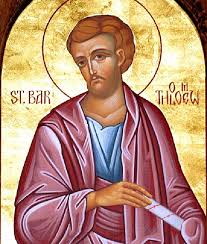
St. Bartholomew

St. Bartholomew was one of the Twelve Apostles of Jesus. He has been identified with Nathanael (alternatively spelled Nathaniel),who appears in the Gospel according to John as being introduced to Christ by Philip (who would also become an apostle).
Bartholomew was born at Cana of Galilee and is listed among the Twelve Apostles of Jesus in the three Synoptic gospels: Matthew, Mark, and Luke, and also appears as one of the witnesses of the Ascension; on each occasion, however, he is named in the company of Philip.
Two ancient testimonies exist about the mission of Saint Bartholomew in India. These are of Eusebius of Caesarea (early 4th century) and of Saint Jerome (late 4th century). Both these refer to this tradition while speaking of the reported visit of Pantaenus to India in the 2nd century. The studies of Fr A.C. Perumalil SJ and Moraes hold that the Bombay region on the Konkan coast, a region which may have been known as the ancient city Kalyan, was the field of Saint Bartholomew’s missionary activities.
Along with his fellow apostle Jude Thaddeus, Bartholomew is reputed to have brought Christianity to Armenia in the 1st century. Thus, both saints are considered the patron saints of the Armenian Apostolic Church.
He is said to have been martyred in Albanopolis in Armenia. According to one account, he was beheaded, but a more popular tradition holds that he was flayed alive and crucified, head downward. He is said to have converted Polymius, the king of Armenia, to Christianity. Astyages, Polymius’ brother, consequently ordered Bartholomew’s execution.
The 13th century Saint Bartholomew Monastery was a prominent Armenian monastery constructed at the site of the martyrdom of Apostle Bartholomew in the Vaspurakan Province of Greater Armenia (now in southeastern Turkey).
St Bartholomew’s Relics
The 6th-century writer in Constantinople, Theodorus Lector, averred that in about 507 Emperor Anastasius gave the body of Bartholomew to the city of Dura-Europos, which he had recently re-founded.[15] The existence of relics at Lipari, a small island off the coast of Sicily, in the part of Italy controlled from Constantinople, was explained by Gregory of Tours[16] by his body having miraculously washed up there: a large piece of his skin and many bones that were kept in the Cathedral of St Bartholomew the Apostle, Lipari, were translated to Beneventum in 803, and to Rome in 983 by Holy Roman Emperor Otto II, conserved at the basilica of San Bartolomeo all’Isola. In time, the church there inherited an old pagan medical centre. This association with medicine in course of time caused Bartholomew’s name to become associated with medicine and hospitals. Some of Bartholomew’s skull was transferred to the Frankfurt Cathedral, while an arm was venerated in Canterbury Cathedral.
Miracles of St. Bartholomew
Of the many miracles performed by Bartholomew before and after his death, two very popular ones are known by the townsfolk of the small island of Lipari.
The people of Lipari celebrated his feast day annually. The tradition of the people was to take the solid silver and gold statue from inside the Cathedral of St Bartholomew and carry it through the town. On one occasion, when taking the statue down the hill towards the town, it suddenly became very heavy and had to be set down. When the men carrying the statue regained their strength, they lifted it a second time. After another few seconds, it got even heavier. They set it down and attempted once more to pick it up. They managed to lift it but had to put it down one last time. Within seconds, walls further downhill collapsed. If the statue had been able to be lifted, all the towns people would have been killed.
During World War II, the Fascist regime looked for ways to finance their activities. The order was given to take the silver statue of St Bartholomew and melt it down. The statue was weighed, and it was found to be only a few grams. It was returned to its place in the Cathedral of Lipari. In reality, the statue is made from many kilograms of silver and it is considered a miracle that it was not melted down.
St. Bartholomew is credited with many other miracles having to do with the weight of objects.
St. Bartholomew has the following Patronage